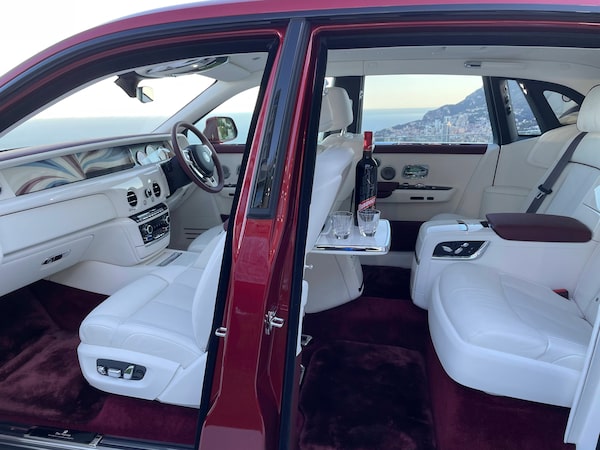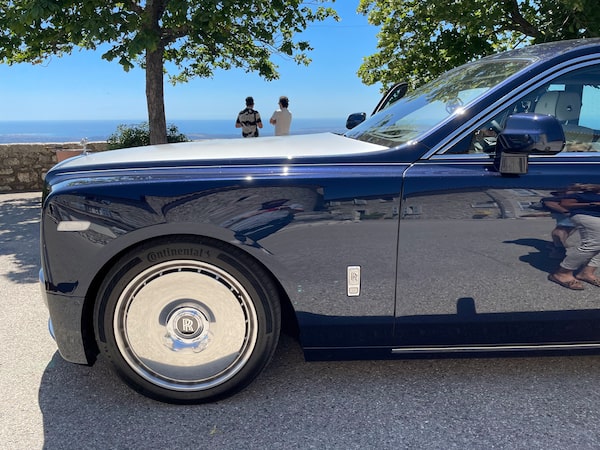
Rolls-Royce's official flying-lady mascot, the Spirit of Ecstasy – yes, that’s really what they call it – stands proudly on the hood of the Phantom.Matt Bubbers/The Globe and Mail
The Rolls-Royce Phantom is a car for people who have lots to celebrate. How else to explain why this rolling palace can be stocked like a bar cart? There’s an optional liquor cabinet with a pair of lowball glasses beneath the rear arm rest and a champagne cooler between the rear seats. The cup holders aren’t designed for cups; they’re made to embrace the petite champagne flutes included in the rear fridge. I guess the fridge could be filled with cans of La Croix, but it seems like overkill for sparking water.
The Phantom is itself a celebration – of an owner’s wealth, success and status (or at least the wealth of their ancestors).
Since 1925, through eight iterations, the Rolls-Royce Phantom has been shuttling around royalty; both Queen Elizabeth and LeBron (King) James have one.
Nothing else even comes close to a Phantom. Bentley stopped producing its flagship Mulsanne sedan in 2020 and the Mercedes-Maybach S-class is barely half the price of the big Rolls. The British company is coming off a banner year, having delivered a record 5,586 cars worldwide in 2021, but Rolls has nevertheless given the Phantom the slightest of exterior design tweaks for 2023 to keep it fresh.
Mixing with regular traffic, the gargantuan proportions of the company’s flagship make other cars – heck, the whole world – look smaller, which is surely part of its appeal for some of the automaker’s wealthy clientele. Riding in it is a power trip; it’s meant to draw attention.
From inside, the Phantom doesn’t feel like other cars. It doesn’t pitch forward as you’d expect under braking or roll sideways in corners. There’s a sense of motion, but it feels disconnected from the road and whatever’s going on outside. Rather than a car, it feels more like being on a big boat or private jet. Only when compared to those other modes of transport could anyone ever convince themselves the Rolls-Royce is reasonably priced.


The Rolls-Royce Phantom, which starts at $560,500, comes stocked like a bar cart.Matt Bubbers/The Globe and Mail
The updated 2023 Phantom – now called the Phantom Series II – starts at $560,500, or $654,900 if you want the truly palatial six-metre-long Phantom Extended. The latter is every kingpin’s dream; it’s halfway to a stretched limo, much longer even than the largest three-row Cadillac Escalade ESV. (That’s Cadillac talk for Escalade Stretch Vehicle.)
Nobody pays the suggested retail price on a Phantom, though. Customers often have Rolls-Royce’s bespoke division embellish their cars with embroidered silk ceilings or dashboard inlays made of 3,000 iridescent tail feathers or wood from rare Hawaiian Koa trees. The Phantom’s upper dashboard is designed to be used as an art gallery, a glass-covered showcase for whatever an owner cares to put there. One customer, for example, commissioned an original painting by South African artist Esther Mahlangu. (Meanwhile, the rest of us are driving around with bobbleheads and fuzzy dice in the window.)
Depending on how ambitious, picky and/or indecisive a client is, it can take up to four years to complete a Phantom build. In the case of the Koa wood car, it took three years just to find the perfect piece of timber, one of Rolls-Royce’s designers said.
As a result, the average selling price of a Phantom is roughly $750,000 before taxes, according to a company spokesperson, and some customers have spent more than $1-million. It’s not that money is no object; money is precisely the object. The more it costs, the better. The idea is to show off.
Given its sheer size, however, the Phantom can be an unwieldy beast to drive, especially through the tight confines of downtown Nice. The last-generation BMW navigation system doesn’t seem to understand how large this car is, and insists on routing us through a series of progressively narrower roads until it demands we make a tight left through a gauntlet of jagged stone walls. There’s no way to back out. I’m fully clenched as the Phantom squeaks through the alleyway with two inches to spare on either side of its mirrors, narrowly avoiding an Ever-Given-Suez-Canal situation.
Up in the mountains, the big Rolls can run free. As gaggles of spandex-clad cyclists struggle up the Col de Vence, a well-known 17-kilometre route near Nice with 900 metres of climbing, the Phantom ascends as if the mountain were not there. There’s a 6.75-litre twin-turbo V12 engine under the hood somewhere, but you’d never know because it’s silent as we loaf up and down the Alps. Hannibal would’ve loved this thing.
Steering takes almost no effort; an index finger on the wheel will suffice. The brand’s official flying-lady mascot, the Spirit of Ecstasy – yes, that’s really what they call it – stands proudly on the hood. She’s so far away that, from the driver’s seat, it seems the Spirit goes around corners long before the rest of the car. Below her, the vertical columns of the car’s Parthenon grille must be imposing, because oncoming vehicles tend to give the Phantom a wide berth.
Rolls-Royce is the last purveyor of V12-engined sedans in North America, but its days are numbered. Given Rolls-Royce’s announcement that its vehicles will be all-electric from 2030, and the fact that this eighth-generation Phantom is barely in the middle of its life cycle, the next-generation of this grand sedan will almost surely be battery powered. The shift isn’t because owners are fretting over the Phantom’s fuel consumption (20 litres per 100 kilometres in the city and 11.8 on the highway), but instead because EVs are the future.
After the near-miss in the Nice alley, I’m happy to let one of Rolls-Royce’s chauffeurs tangle with Riviera traffic through Monaco on the way back to our hotel. Stretched out in the back of the car, the champagne fridge makes sense; riding in a Rolls-Royce Phantom is an occasion worth celebrating. The Mediterranean flickers in and out of view, and before I know it, we’ve arrived.

The flying-lady mascot is so far from the driver’s seat, it seems it goes around corners long before the rest of the car.Matt Bubbers/The Globe and Mail
The writer was a guest of the auto maker. Content was not subject to approval.
Shopping for a new car? Check out the new Globe Drive Build and Price Tool to see the latest discounts, rebates and rates on new cars, trucks and SUVs. Click here to get your price.